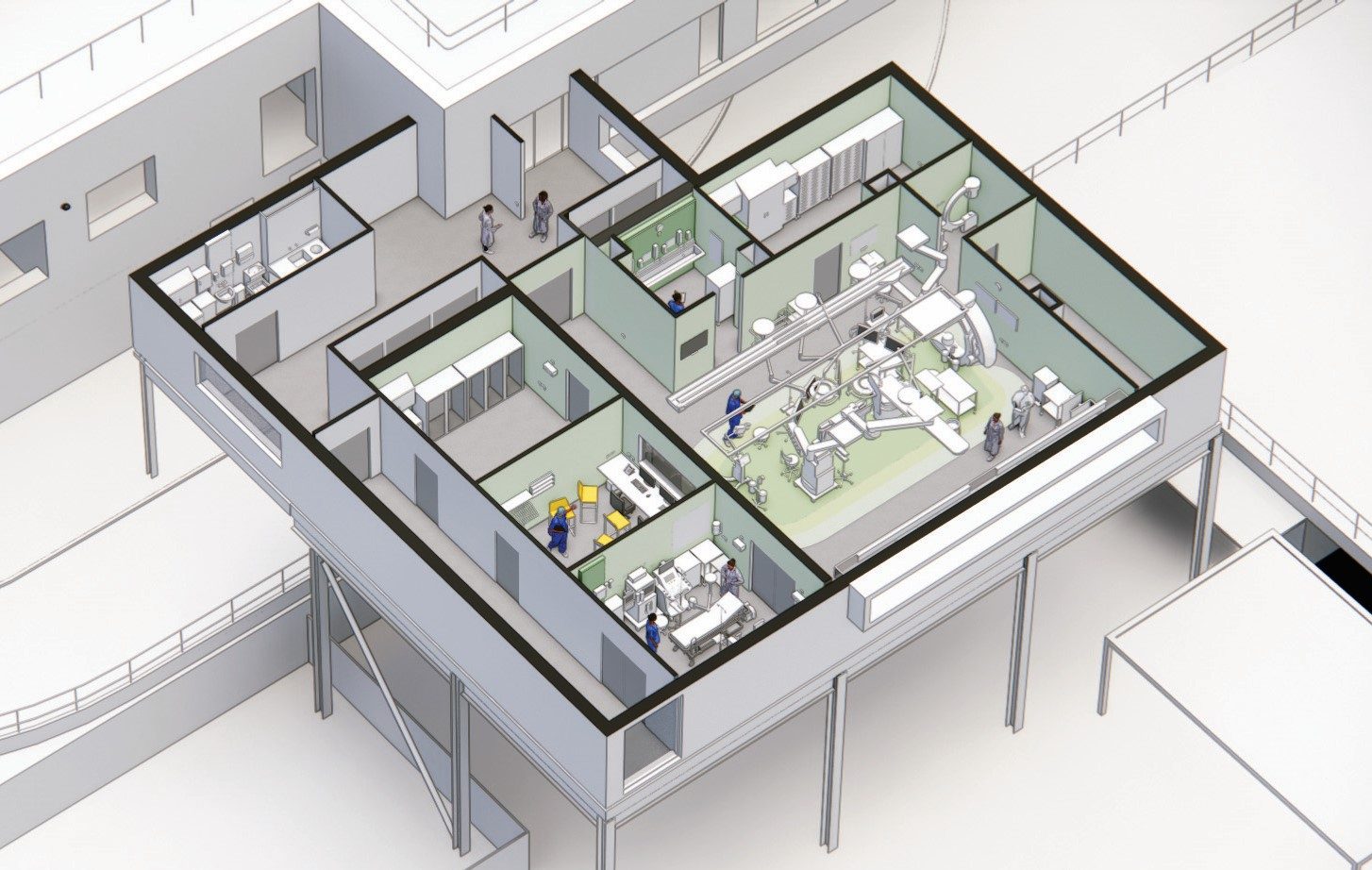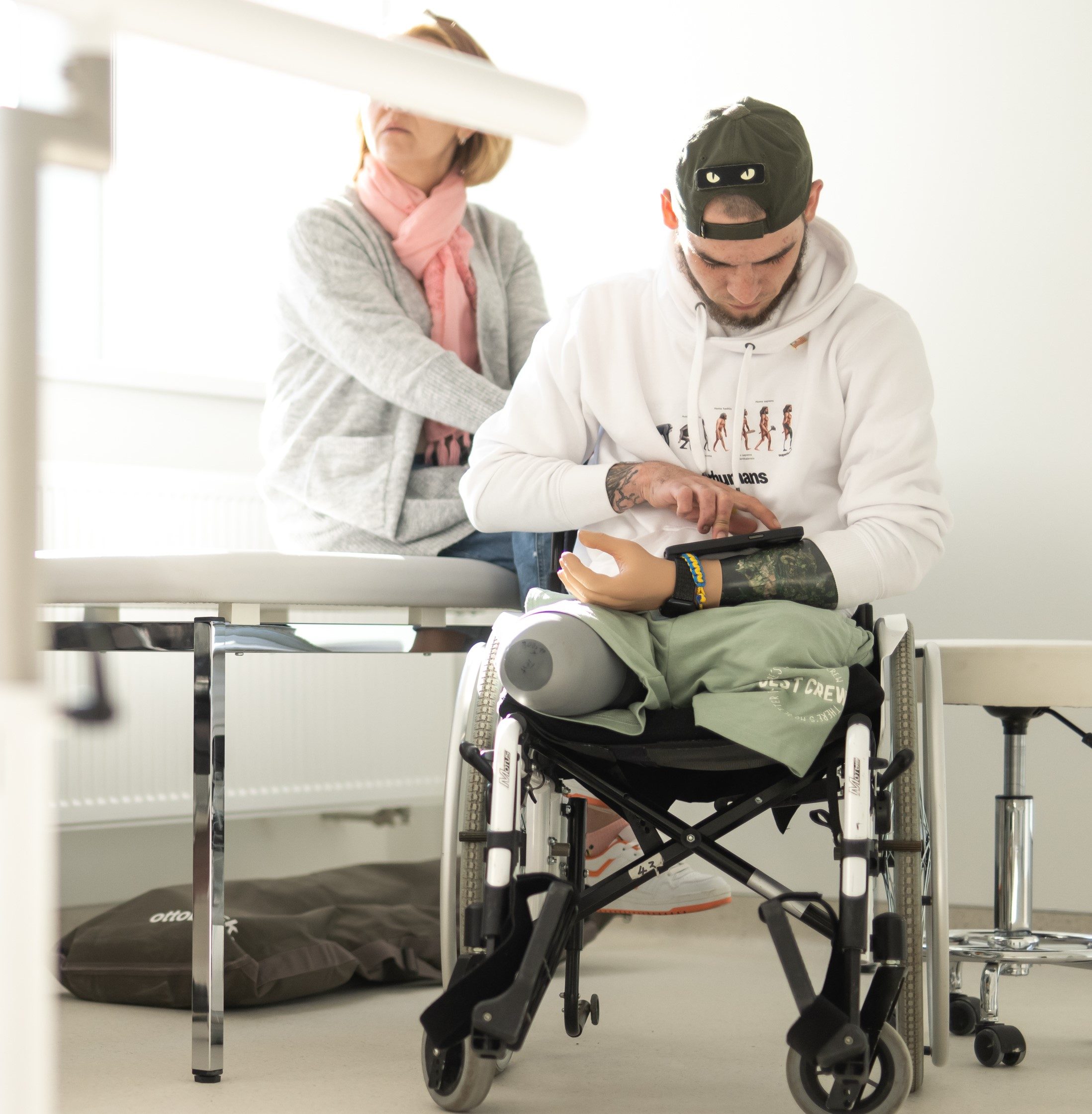A superior surgical space
The design and delivery of a state-of-the-art hybrid vascular theatre at Lister Hospital will enable it to become a specialist surgical hub for the region.
Lister Hospital has received funding to build a hybrid vascular theatre, which combines the aseptic environment of a modern surgical operating room with advanced medical imaging devices. This means complex procedures can be undertaken with the assistance of radiology-guided techniques and full anaesthetic support, in an environment with high-quality lighting and a continuous flow of bacteria-free air. Less invasive procedures can be performed with improved accuracy and at lower radiation doses, benefitting both the theatre team and the patient.
The new theatre also integrates streaming and conferencing facilities so surgeons can teach in real time. Additional technology includes an Ultra Clean Air System provided by Medical Air Technology (MAT) – the first of its kind in the NHS – delivering 500 air changes per hour. There are also two medical gas pendants on double swing arms to give greater reach and flexibility.
Jaime Bishop, Health Spaces Architectural Lead, commented: “One aspect that is technically complicated is the combination of the ultra-clean ventilation [UCV] overhead with an overhead image intensifier – the rails the latter runs off interrupt the ability to ventilate to UCV standards, so we had to co-ordinate those two.”
He also highlighted the need to create a pleasant place to work: “If you look at models, particularly on the continent, you’re much more likely to see an operating theatre with windows. This is a place of work and these highly skilled people have the same needs to stay in touch with their circadian rhythms.”
The theatre will ensure round-the-clock access to early diagnostics, decision-making expertise and emergency procedures. As vascular services are highly specialised, consolidating services, procedures and specialists into a main surgery hub in the region will help to sustain clinical expertise and improve outcomes for patients.
The theatre is due for completion in the first half of 2024. The complexity of the project has demanded input from a wide range of internal and external stakeholders, who spoke to Fortis about the scheme.
Better outcomes for all – Matthew Metcalfe, Consultant Vascular Surgeon
From a vascular surgery point of view, we know that dealing with a large volume of complex cases gives you better outcomes – so rather than having 10 hospitals, each doing five cases, it’s better to have one or two hospitals doing 25 or 50 cases. There were several years of reviews to see how one unit might work, and Lister was chosen as the site.
We needed to build a hybrid theatre to meet the specifications to become a vascular hub, so we looked at the various options – whether it was a new build or conversion from the existing building. After analysing all the options, the best solution in terms of cost and practicality was a new build located near main theatres as an extension, which will not only work with the current operational goings on, but is also future-proofed.
Health Spaces created several designs to determine in which order we needed the rooms for reduced transit for the patient, but also to make sure that all the Trust requirements were met in terms of infection and fire risk scenarios. It was interesting to watch the 3D walkthrough and, with the VR headset on, get a real idea of the space. There were several tweaks to get the flow right and the whole team had input into the floorplan and the various rooms to ensure individual requirements were met – everything down to where we wanted the windows and cupboards.
We visited other units to decide whether to have a ceiling- or floor-mounted system, and again analysed different options. Ceiling-mounted was thought to have the most benefits, but there were lots of challenging conversations about how we fit a ceiling-mounted C-arm into the theatre around the ventilation aspects that reduce infection risks, which is massively important for vascular surgery.
The large space gives us the capacity to have a table to do x-rays with the mobile floating C-arm, but also to park the C-arm to the side and bring a new table into the operating theatre without the other operating table and equipment getting in the way of staff and that operation. So effectively, you can do two types of operating in the same theatre. This will enable us to do a wide range of procedures, including more complex and varied operations.
There are some key innovations in the theatre, such as the movable table and the C-arm, which enable us to do more accurate radiological imaging, which reduces radiation exposure for both the patient and the staff, and also reduces the duration of the operation. There was a fantastic presentation recently from one of our trainees in the region about extra protection needed for women in terms of breast radiation and the fact we’ve got to cover the armpits better. We can now give them badges which show their radiation exposure during the procedure as being minimal. We’ve got to look at how we’re going to protect our staff.
We’ve got an excellent team of people at Lister, but there’s only so much we can do at the moment. Being able to expand our workload offers new improvements, changes and developments that will entice other people to get involved. Leading technology helps draw people in to learn here and helps with staff retention, giving current staff new aims and challenges so they’re not bored of doing the same operation – they’ve got something new to work towards and learn.
Creating a high-performance network – Professor Sadasivam Selvakumar, Vascular Network Clinical Lead and Consultant Vascular Surgeon
I was the solo surgeon when I started in 1998 before my two colleagues joined me, but we had a mission to create this hub all along. I had to work out how to make this unit bigger and get the right people to make it an effective investment – it took time, but it’s very satisfying to finally see the project begin.
Our first meeting with Health Spaces was to establish exactly what we were looking for. After that, we formed a group of clinicians, radiologists, radiographers, theatre nurses, finance managers – everybody who needed to be involved – to consult on the process. The 3D diagrams were really useful because we could immediately understand how our suggestions would look.
Three hospitals – here, Hertfordshire and Essex – do this work. By bringing these three sites to one place, we will have 24/7 consultant-led vascular emergency cover for the patients and, over the number of procedures we’ll do, this will keep our competencies at a high level. Lister is ideally placed because it is equidistant between Hertfordshire and Essex.
This network will benefit dialysis patients, cardiac patients and vascular patients from this region. It will bring in 10 vascular surgeons, seven radiologists, sonographers and theatre nurses with variable interests. This will allow us to be super specialised so that we can do things that will also be of interest for research and we’re planning to have an academy of surgeons – and it will also benefit the junior doctors, with high-level surgical doctors training them.
Bringing plans to life – Kay Wandless, Senior Sister for Vascular, Renal, Colorectal and General Surgery
We started about 10 years ago with some ups and downs applying for funding, but we were finally awarded the hybrid vascular theatre. Health Spaces came up with the main and final drawings and it was a very much a hands-on process whereby we would look at the layout of every room and the patient pathway. For instance, the first plan had the anaesthetic room near to the exit door, which didn’t work, and we have asked for a bigger storeroom than is usual.
During design meetings, we would lean over a desk and move things around – I made the set-up out of Lego so we could physically move things around. Getting all stakeholders engaged was key, and this helped to do that.
We found it useful to visit other hospitals that already had hybrid vascular theatres to find out what they did right, what they did wrong, how they staffed it, where they kept their equipment, etc. We’ve tried to future-proof it with data points everywhere and the teaching side of it, with the camera in the operating light so that people can watch surgeries on screen. Being able to work in a theatre of this size is incredibly exciting for people who want to come and see it, but it’s also going to help with recruitment and attracting people from different regions.
There are many reasons why the theatre is amazing. Not just that it’s new and big, but seeing a brand new theatre has an enormous impact on staff morale. Having access to a space like this will give them room to progress and do more complex cases. The patient pathway is also improved – going through nice areas that aren’t all battleship grey. It’s very exciting for us.
The strong relationship between myself, Selv and Matt has made a huge difference to the design process. We can have that open conversation because there’s no room for egos in this sort of collaboration. When Selv and I retire, Matt will be left working here for quite a few more years, so it needs to be right. The team at Health Spaces were very open to challenges too, and the architects didn’t come in with any preconceived ideas of how it ‘had’ to be.
“Sometimes, engaging in the architectural and design process can be intimidating, so to see that from the team was lovely” Ben Spry, Healthcare Architect
Aesthetic meets technical – Kai Xin Tan, Healthcare Architect
I visited the site early on with the Trust because it’s important to understand the context of such a unique theatre. When you think about vascular theatre, it could be quite technical and generic, and people think it’s a cold environment. We proposed some different, more vibrant colours, and there was also co-ordination on the technical side to understand how things like the C-arm work. How do you combine the aesthetic with the technical elements? We tried to create the best possible environment, so even when the surgeon is doing their job, they can enjoy the space. One of the features is windows to bring natural light in, which is really important in rooms where people spend a long time; surgeons need to look up to give their eyes a little break. I’m really excited to see how it will come to life.
A flexible space – Paul Plummer, Health Spaces Design Manager
I joined the project at the technical design stage, managing the whole design team to include the building as a whole, as well as the theatre and its interface and design within the multi-function mechanical and electrical specialist that we have. We have two storeys of structural steel before the building even starts, which required a detailed interface with the existing piling details on both levels. This stage is about bringing everything and everyone together and making sure the design is robust, so we get full sign off with the client and ensure the clinical team are fully comfortable with the flow of this theatre.
The theatre space is designed so that it can be multi-functional. We’ve got the Philips table that can rotate through 90 degrees and the Philips C-arm that can swing around it. You’ve got the uninterruptible power supply to that as well, so you’ve got the backup within the main theatre.
We’ve got two medical gas pendants by Bender, which are on double swing arms and one has two arms, so they give you a bigger reach. The pendants have all the sockets on and the gas connections are on the anaesthetic pendants, so this is where you get all your connectivity. Bender also provide the surgeons panel, so you can control everything within the room through the panel, including the all-important music!
There’s a 58-inch screen and two double 27-inch screens in there on different mounts for manoeuvrability, offering plenty of viewing capacity for everybody in the room. We’ve introduced flexibility to access control – originally there was push-button release on one side, but now we’ve got it on both sides so it doesn’t matter what side the patient and clinical staff are on.
It’s a really interesting project. We’re using so much different technology, so it’s really engaging.
Breaking convention – Andy Smith, Medical Air Technology (MAT)
A special version of our clean air technology has been created because we had to split the canopy into sections either side of tracks in the ceiling to accommodate the Philips equipment. The resulting three-compartment Ultra Clean Air System is a bespoke unit that has been designed specifically for Lister’s hybrid vascular theatre.
The principles are the same as a traditional ultra-clean theatre: to bathe clean air onto the patient using HEPA filters in a bank directly above. In a conventional theatre, you would have four ceiling air diffusers that would distribute the air in a turbulent fashion and the filtration is provided from the air conditioning system, which is up in the plant room. In an Ultra Clean Air System, the primary air from the plant room is fed into the recirculation fan chambers of the system. Here, it mixes with return air and delivers it to the theatre via HEPA filters.
The surplus of the primary air cascades out from the theatre via separate devices called pressure stabilisers. A theatre needs to be maintained at 25 pascals, so the excess air goes out through these pressure stabilisers, which are balanced to maintain the required pressure. Pressure stabilisers are designed so that, if you open a door into the theatre, a certain amount of air will pass via the doorway to prevent dirty air from coming back and causing cross-contamination.
In a conventional theatre, you would have 22 total room air changes per hour provided by the air conditioning system. With an Ultra Clean Air System, you also get 22 room fresh air changes plus 500 air changes per hour directly below the canopy – a massive difference.
© Dialogue Content Marketing Ltd 2025.
This article was taken from the January 2024 edition of FORTIS magazine.
FORTIS magazine is a Health Spaces Limited publication. Opinions expressed in FORTIS magazine are not necessarily those of Health Spaces Limited or Dialogue Content Marketing Ltd. Material contained in this publication may not be reproduced, in whole or in part, without prior permission of the publishers. No responsibility can be taken on behalf of advertisements printed in the magazine.
FORTIS magazine – read more
This article was written for the January 2024 edition of FORTIS magazine; a forum for the NHS to share ideas, innovations and case studies. To read the publication in full and access digital copies, visit FORTIS magazine. FORTIS magazine is free for NHS change-makers and leaders and is available as a print or digital copy. FORTIS magazine is managed and owned by Health Spaces Ltd.




